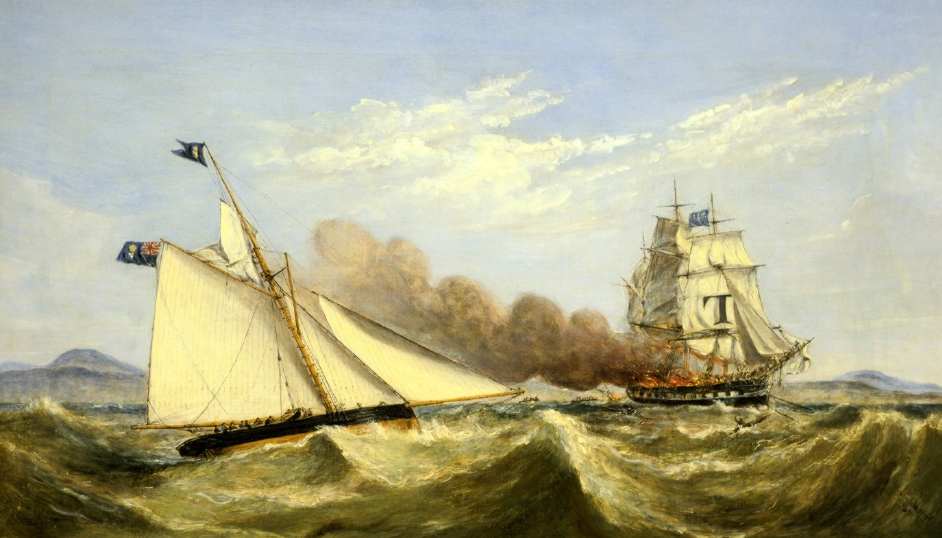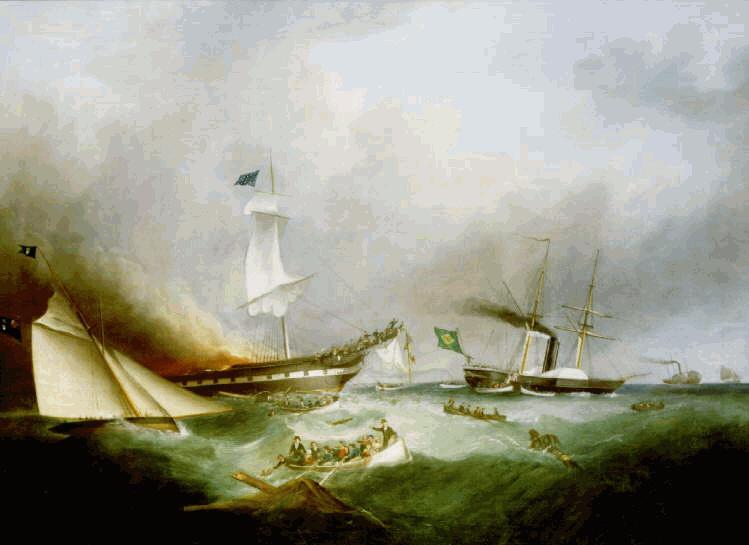
The Ocean Monarch on fire in Liverpool Bay. The yacht Queen of the South is in the foreground. [Painting by Henry Melling]
Information from Wrecks of Liverpool Bay by C. Michael.
Ocean Monarch
American passenger liner (sail)
1301 tons gross, 179 ft long, 40 ft beam, 27 ft draught.
Built: Donald McKay, USA, 1843 [1847, wooden].
Owners: E. Train & Co.(White Diamond Line), registered at Boston.
Date of wreck: 24 Aug 1848
Location: near 53° 25.40' N 3° 35.37' W [OSGB36 Datum]
Distance from New Brighton: 20 nautical miles.
Depth at low water: 17m seabed, no scour, 15m to top of wreck.
By 1848, steamships were carrying around half of the transatlantic passenger trade. Sailing ships were usually almost as fast eastwards but took twice as long on the westbound crossing. Even so, sailing ships were able to provide a regular service in competition. Enoch Train and Company's White Diamond Line ran a weekly Liverpool to Boston service. To attract passengers, they advertised through bookings by rail from Boston to various American cities. Their fleet of ships had the reputation of being well built and, though not especially fast, of being able to keep up a good speed in foul weather.
More and more of the cabin passengers preferred the reliability and speed of steam, so the emigrants travelling steerage were sought by the sailing packets to make good the lost cabin passengers. Life in steerage on an ocean crossing of 30 days or more was uncomfortable. The steerage passengers were packed into accommodation below decks and allocated a wooden box to sleep in. The sleeping accommodation was segregated into male and female. They were only allowed up on deck for short periods each day. On sailing ships they were not served with cooked meals. Basic supplies of tea, porridge and biscuits were provided as well as cooking places. They were expected to bring extra food, a straw mattress, plates and (on some ships) a chamber pot.

The Ocean Monarch on fire in Liverpool Bay. The
yacht Queen of the South is in the foreground.
[Painting by Henry Melling]

The Ocean Monarch on fire in Liverpool Bay. The Brazilian frigate
Affonso at right and the
yacht Queen of the South is in the foreground.
[Painting by Samuel Walters]
The Ocean Monarch left Liverpool early on the morning of Thursday 24 August. She had 396 people aboard, of whom 322 were steerage passengers. She had 32 cabin passengers and 42 crew. Her cargo was iron, dry goods, salt and earthenware. The earthenware was packed in crates stuffed with straw. She was towed out by a steam tug and at about 8.00 am, she set off under sail in a fresh breeze. Nothing of any consequence happened until about midday when she was 6 miles short of Great Ormes Head.
Smoke was discovered in one of the aft cabins. Despite attempts to put the fire out with buckets of water, it spread quickly. The ship was steered downwind to try to lessen the apparent wind but this just resulted in smoke getting everywhere. This caused confusion among the passengers. As panic broke out, Captain Murdock ordered the two anchors to be released to bring her bow up wind. The passengers crowded forward and onto the bowsprit to distance themselves from the flames astern. Many jumped overboard and, although a few caught hold of floating wooden objects, many drowned. The captain had difficulty giving orders amid all the screams. He ordered the boats to be lowered and two were successfully launched. The rest were engulfed in flames. The wooden topgallant yard was cut down and held alongside with a rope so people could cling to it when they jumped overboard.
The sad tragedy unfolding was seen by several boats in the vicinity. The first to arrive was the yacht Queen of the South. This belonged to Mr. Littledale who was Commodore of the Royal Mersey Yacht Club and who was returning from a regatta at Beaumaris. He and his crew managed to save 32 people. The scene which he witnessed was most appalling and harrowing. Flames were bursting furiously from the stern and centre of the vessel. To escape them, the passengers crowded in the fore part. Some jumped overboard and were not seen again. In turn the mizzenmast and then the mainmast went overboard. The foremast still stood. As the fire crept forward, the passengers and crew were forced forward too. They clung to the jib boom in clusters - even one lying on top of another. At length the foremast went overboard which snapped the fastenings of the jib boom. This boom with its load of humanity then dropped into the water amidst the most heart rending screams. Some regained the vessel or a floating spar but many were lost.
The next vessel to assist was the Brazilian steam frigate Affonso which was out on a pleasure excursion. She was commanded by Captain Lisboa and had on board the Prince of Joinville, the Duke d'Aumale, the Brazilian Minister the Chevalier de Lisboa, Admiral Grenville and their parties among other distinguished persons. She was able to anchor close by and lower 4 boats to pick up survivors. About 160 were rescued and received attention aboard the Affonso.
Another vessel lending assistance was the Bangor bound steamer Prince of Wales. She and the American ship New World used their boats to pick up survivors clinging to floating wreckage. Towards the end of this tragic affair, there were only a few helpless women and children left on the wreck. They were paralysed with fear and unable to get down from the tottering bowsprit into the waiting boats. They were saved by an act of heroism by Frederick Jerome who stripped and swam to the wreck with a line in his hand. He succeeded in lowering the last victims to safety and was himself the last to leave the wreck. Mr. Jerome was a sailor on the American ship New World but was British, having been born in Portsmouth. He had previously shown courage in an incident when the packet ship Henry Clay was stranded near New York.
Not all assistance was so selfless and there are contemporary reports of passengers in one of the Ocean Monarch's boats who were picked up by a Chester pilot boat Pilot Queen and robbed. Then they were returned to their boat while the Pilot Queen went back to the wreck scene to look for more valuables, such as floating trunks.
The Ocean Monarch continued to burn until the flames got down to the water line. Apart from the figurehead which was intact, she looked as if she had been neatly cut a few inches above the water. In fine calm weather, she sank at anchor during the night. There was a hissing and cracking sound as the flames were extinguished and she slid beneath the waves, stern first. The figurehead floated off and was eventually recovered at Rhos and used to decorate a wall in a hotel.
The loss of the Ocean Monarch was one of the worst disasters that occurred to emigrant ships. In total 178 lives were lost. Various reasons for the fire were claimed - that pipe smoking passengers were responsible, that careless use of a candle by the crew was responsible,..
A collection was made to assist the survivors and a considerable sum was donated. Awards were made by the Liverpool Shipwreck and Humane Society to the rescuers: to Mr. Littledale and the crew of his yacht, to Admiral Grenfell and Captain Lisboa, and to Frederick Jerome. Although the Prince of Joinville is said to have given succour to the afflicted when brought aboard the Affonso, he also found time to sketch the tragedy. This picture graphically tells the dreadful tale.
The wreck site is assumed to be the Ocean Monarch. She is marked
as "position approximate" on the chart with the position given
above. I estimate that her true position is closer to
53°25.354' N, 3°35.577' W [WGS 84 Datum].
The wreck was originally found from information
obtained by a trawler that caught her nets on an underwater
obstruction. The wreck is apparently on an even keel but only a metre
or two above the level of the surrounding seabed. She lies north -
south and appears to be of wood with iron cylinders scattered around.
There is some coarse fishing net caught on one side. The wreck was
salvaged a few years ago without any treasure being recovered. The main
feature of note is the amount of pottery to be found. Indeed this site
is known locally as the "plate wreck". This wreck is a
"Conger City". Every crack seems to have its resident mean grin. I
have seen a dozen congers during one dive.
Postscript: some extra information on salvage:
Chester Chronicle - Friday 29 September 1848 [From Liverpool Albion]
The Ocean Monarch. We mentioned last week that the steam-tug
Skerryvore had proceeded to the spot [buoyed] where this ill-fated vessel sunk for
the purpose of recovering, if possible, some portion of the wreck. The
steam-tug had on board a skilful diver, with the necessary dress or
apparatus; but his efforts so far have met with but little success. On
Thursday, some chains and other iron materials that had been recovered
were brought to this port, and on Saturday night, the Skerryvore arrived
in the Mersey with the following articles raised since Thursday:- One
anchor, fourteen cwt. chains, and a quantity of steel and merino.
Although up to latest accounts these are the only proceeds, sanguine
hopes are entertained, and operations are still proceeding.